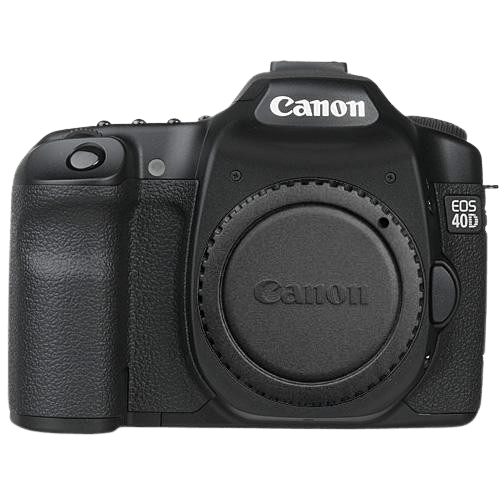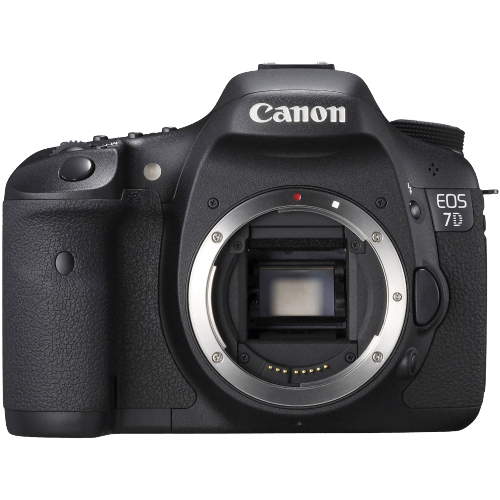Canon EOS 40D vs EOS 7D Comparison
Canon EOS 40D

Canon EOS 7D

The Canon EOS 7D outperforms the Canon EOS 40D with a score of 45/100 compared to the 40D’s 42/100. Both cameras are DSLRs, released in 2007 and 2009 respectively, and share similar dimensions, with the 7D slightly larger at 148 x 111 x 74mm and heavier at 860g.
The EOS 7D’s higher score reveals its superiority in certain aspects, such as improved performance and features. However, the EOS 40D holds its ground with a more affordable launch price of $899, compared to the 7D’s $1974.
Taking these factors into account, the Canon EOS 7D is the better camera, albeit at a higher price. The Canon EOS 40D, while not as feature-rich, offers a more budget-friendly option for DSLR enthusiasts.
Canon EOS 40D vs EOS 7D Overview and Optics
The Canon EOS 40D narrowly outperforms the Canon EOS 7D in optics, scoring 45/100 compared to the 7D’s 43/100. Both cameras share several specifications, such as a CMOS sensor type, APS-C sensor size, Canon EF-S lens mount, and no image stabilization.
Despite its lower megapixel count of 10.1, the Canon EOS 40D achieves a higher DXOMARK score for the sensor at 64, compared to the 7D’s 66. This result indicates that the 40D’s sensor performs better in terms of image quality and dynamic range. Furthermore, the 40D is equipped with a Digic III processor, which is known for its efficient power consumption and image processing capabilities.
On the other hand, the Canon EOS 7D offers a higher megapixel count at 18, allowing for larger and more detailed prints. Additionally, the 7D boasts a faster shooting speed of 8 frames per second, making it a better choice for action photography. The Dual Digic 4 processor found in the 7D also provides impressive image processing speed and performance.
While both cameras have their strengths, the Canon EOS 40D’s superior sensor performance and efficient processor make it the winner in terms of optics. However, the Canon EOS 7D is still a strong contender for those who prioritize a higher megapixel count and faster shooting speed. Ultimately, the choice between these two cameras will depend on the specific needs and preferences of the photographer.
Canon EOS 40D vs EOS 7D Video Performance
When comparing the video capabilities of the Canon EOS 40D and the Canon EOS 7D, it is important to note that the Canon EOS 40D does not have any video functionality. This means that this camera cannot record any videos, making it unsuitable for users who require video capabilities in their camera.
On the other hand, the Canon EOS 7D has video capabilities, with a video score of 43 out of 100. This camera can record videos in Full HD, with a maximum resolution of 1920 x 1080 pixels. The EOS 7D also offers a maximum video frame rate of 30 frames per second, which is suitable for most general video recording purposes. However, it is worth noting that the Canon EOS 7D does not have built-in time-lapse functionality, which may be a drawback for some users who require this feature.
Taking the video capabilities into consideration, it is clear that the Canon EOS 7D is the better choice for users who need video functionality in their camera. The Canon EOS 40D, lacking any video capabilities, is not suitable for those who require video recording features. Therefore, the Canon EOS 7D is the more versatile option of the two cameras when it comes to video capabilities.
Canon EOS 40D vs EOS 7D Features and Benefits
The Canon EOS 7D wins the feature comparison with a score of 54/100, while the Canon EOS 40D scores 36/100. Both cameras share some common specifications, such as a 3-inch screen size, absence of a touchscreen, flip screen, GPS, WiFi, and Bluetooth. However, there are differences that make the EOS 7D a better choice.
The EOS 7D screen resolution is 920,000 dots, which is four times higher than the 230,000 dots resolution of the EOS 40D. This higher resolution translates to a clearer and sharper display, allowing for better image review and composition. The EOS 7D also has a higher feature score, which means it offers more advanced functions and settings for users to optimize their photography experience.
On the other hand, the EOS 40D does not excel in any particular aspect compared to the EOS 7D. Its lower feature score and screen resolution make it less appealing for those seeking top-of-the-line camera specifications. However, it might still be a suitable choice for beginners or those on a budget, as it is likely to be more affordable due to its older release date and lesser features.
Based on the comparison, the Canon EOS 7D is the superior camera in terms of features and screen resolution. It caters to more advanced photographers who require higher quality display and additional functions for their work. The Canon EOS 40D, while not excelling in any area, may still serve as an entry-level camera for those seeking a more budget-friendly option.
Canon EOS 40D vs EOS 7D Storage and Battery
The Canon EOS 40D and the Canon EOS 7D both score 35/100 in storage and battery, indicating no clear winner in this category. Both cameras share some common specifications: they each have one memory card slot and do not support USB charging. Their battery life is also identical, providing 800 shots per charge.
The Canon EOS 7D has an advantage in terms of memory card compatibility, accepting Compact Flash (Type I or II), UDMA, and Microdrive cards. This versatility allows users to choose from a wider range of storage options. On the other hand, the Canon EOS 40D only accepts Compact Flash (Type I or II) cards.
In terms of battery type, the EOS 7D uses the LP-E6, while the EOS 40D utilizes the BP-511. There is no clear advantage for either camera in this aspect, as both batteries offer the same number of shots per charge.
Given these specifications, neither camera outperforms the other in storage and battery capabilities. While the EOS 7D offers slightly more memory card compatibility, this difference may not be significant enough to impact a buyer’s decision. Both cameras provide similar performance in terms of battery life and charging options.
Canon EOS 40D vs EOS 7D – Our Verdict
Are you still undecided about which camera is right for you? Have a look at these popular comparisons that feature the Canon EOS 40D or the Canon EOS 7D:
